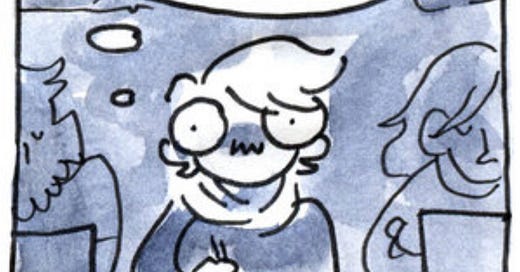I want to open this post with the words that Marnie Galloway closed her artist’s talk with:
“To everyone in the room, I also want to invoke a call to action, medievalists and cartoonists alike. I invite all of you to draw more. Draw your ideas and questions, draw what you had for breakfast, draw the weirdest panels in the medieval manuscripts, draw the trees outside. The act of drawing is just as much an act of thinking as writing prose scholarship. It is anti-pretentious and can be deeply intellectual, and is part of a long history of people sitting at desks illuminating manuscripts, trying to decode the heavens and the meaning of it all. We are a part of that too.”
Marnie’s closing call to action makes more bold my own desire/inclination to invite people in to both of my disciplines. It is this desire, in part, that planted the seed of the Newberry event.
My first experience with medieval literature was a class on Chaucer’s Troilus and Criseyde back in 2018, my first semester of going back to school. If you have ever been in the audience of a talk I’ve given, you might know what happens next:
Already antsy about being the “mature student” in the room and unsure if I could even handle being at university again, these first sessions nearly broke me. By six weeks into the term, however, I was a convert and it was that class that would go on to make me a medievalist and Chaucerian. More importantly, though, it was that moment of fear and anxiety on the first day of class that made me the kind of medievalist and Chaucerian I am. It’s something I’ve been thinking about quite a bit recently.
Once Chaucer “clicked” for me, I could not stop thinking about both his work and the robust body of scholarship that has grown up around it. I still think about Chaucer all the time (friends and family will attest to this, with varying degrees of perplexity, dejection, and gentle eyerolls). It’s not just Chaucer’s writing, though, which I’ve tried to explain in the past. The best way I can find to describe it is that “Chaucer” is the lens I use to think about other things that interest or even preoccupy me. I’m interested in how stories move through time, in how people deal with love and loss and grief, in what it means to read and write, in ducks with hats1: Chaucer has something to say about each of these things. Digging further into what Chaucer wrote then gives me an approach and vocabulary through which to reflect on what I think and feel. (I think more ducks deserve hats.)
One of my main interests is preventing other people from experiencing that “I am not smart enough” moment when it comes to Chaucer and medieval texts more broadly. Perhaps not preventing it so much as lessening it? I want these texts to feel inviting and accessible, even in Middle English, and I happen to think marrying comics to Chaucer is one excellent way into this self-set task. This was my inspiration to introduce cartoonists to professional medievalists and their scholarly work: I was hoping connections might be made that would bring more comics inspired by and even adapted from medieval texts into the world.
There’s more to it than just that, though. It turns out that making comics also helps me to think through my reading and my research. It’s slow work and allows lots of time for reflection and mind-wandering as the lines pile up and images take shape. Marnie absolutely nailed this quality above: “The act of drawing is just as much an act of thinking as writing prose scholarship. It is anti-pretentious and can be deeply intellectual.” Drawing is an act of thinking and it’s the particular form that my practice-based research takes.2 This facet was the inspiration behind introducing medievalists to cartooning and to cartoonists: I hoped more of them might experiment with making drawings of their own and also collaborating with cartoonists on projects that could bring their brilliant medieval scholarship to a broader audience. “Anti-pretentious and deeply intellectual” sounds like exactly what we as an academic community could use a bit more of. The majority of the medievalists I’ve met are absolutely lovely people who care deeply about sharing and making accessible the work they do and I want to do my part to highlight these qualities.
Our “Cartooning the Medieval” project will not end with this symposium, which is lovely news for me! I know of one medievalist/cartoonist collaboration already taking root and I suspect I will hear of more as the months progress and we unroll the next part of this project. (It’s still a secret: stay tuned!) My co-organizer and I have pitched an article for a journal on the subject and are also designing a workshop on collaboration, community, and public engagement for conferences coming up next year. Initial planning for a follow-up event is also in the works. Until then, I invite you, in Marnie’s words, to “[d]raw your ideas and questions, draw what you had for breakfast, draw the weirdest panels in the medieval manuscripts, draw the trees outside.” What will you draw today?
The broad umbrella under which this approach falls is “creative criticism” or “creative-critical” work. In the interest of highlighting and advancing this approach and its practitioners in medieval studies, two friends and I have founded a professional organization, the Guild of Medievalist Makers.






Sounds like Chaucer functions for you like creative constraints do for me—a conduit that helps you see the interconnectedness of all kinds of media and thought.
Hear hear on that quote! "The act of drawing is just as much an act of thinking as writing prose scholarship. It is anti-pretentious and can be deeply intellectual."